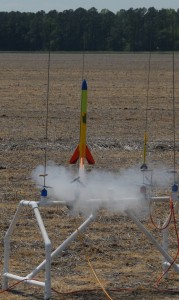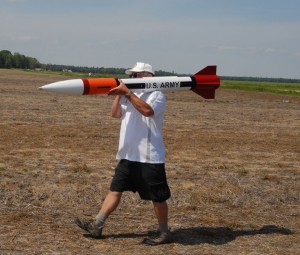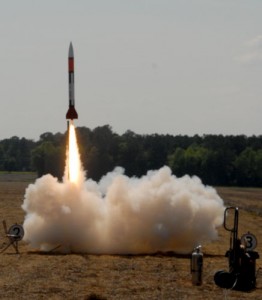This was the last launch of the 2012-2013 Bayboro season, and the weather was almost ideal.? I don?t recall when I have ever had so much fun at a 2-day sport launch!? It was a great weekend, one of those occasions when it was good to be alive.? The weather forecast for the weekend was not promising on Thursday and Friday, but it wasn?t bad enough to consider cancelling, and the reality turned out to be a lot better than the predictions.? Saturday began in the high 50?s warming to the mid 60?s by the middle of the day.? The winds were out of the SSE at 5-10 MPH shifting around to the SE at about 4-7 MPH later in the day.? Sunday dawned almost dead calm and the temperatures were in the low 60?s, warming to the mid 60?s by 1:30.? Rain was in the forecast for Sunday, but all we saw was increasing (very) high clouds.? I didn?t see any rain until around sunset when I was driving around Raleigh on my way home.? The only thing that kept the weather situation from perfection was the wind direction.? The closest tree line on the field is to the northwest, precisely where the winds were blowing.? We lost 2 rockets this weekend, one flown on an A motor and the other on a B.? I?ll have more to say about one of those flights later, it was a strange occurrence, to say the least.? First, the motor use summary and then we?ll look at some details:
|
Size |
Sat | Sun |
Total |
|
A |
7 |
3 |
10 |
|
B |
3 |
6 |
9 |
|
C |
4 |
2 |
6 |
|
D |
8 |
1 |
9 |
|
E |
2 |
5 |
7 |
|
F |
0 |
||
|
G |
2 |
1 |
3 |
|
H |
4 |
4 |
|
|
I |
3 |
4 |
7 |
|
J |
1 |
1 |
2 |
|
K |
1 |
2 |
3 |
|
All |
35 |
25 |
60 |
I have mentioned this before, but not recently, so this is a good occasion to remind everybody of how I add up the ?motor use summary?.? The numbers are actually total flight summaries, and each flight of a complex or staged rocket is classified by the total installed impulse of all the motors.? I have several good examples to cite this weekend:
1.? On Saturday we saw four staged or clustered flights with motors that added up to a D in total impulse:? Chuck Hall flew his Omega-Scrambler with modified payload section on a cluster of 3 B6?s, Ed Withers used the same combination for a very nice flight of his Goliath, Mike Collier flew his Status-1 (or is that Stratus-1?) on 2 C6?s, and Ed Withers flew his Corrected Mistakes on a B6 staging to a C6, which just barely made it into the D range.
2.? Then, on Sunday we saw two flights by Andrew  Billin that totalled in the E range:? his WAC-Corporal? which staged a D12 to a B6, and then another staging project, another Omega which staged a D12 to a D12.
Billin that totalled in the E range:? his WAC-Corporal? which staged a D12 to a B6, and then another staging project, another Omega which staged a D12 to a D12.
We are also very pleased to welcome two flyers who have never visited Bayboro before.?? Todd Bowman recently moved to the Elizabeth City region from Pittsburgh, and he flew a stout Wildman kit called the Darkstar jr on an H250.? On a day when most people were making long walks to recover relatively short flights, Todd dropped this rocket only about 20 yards from the pad!
Dan Mathers is a regular with the Charlotte club, and has been thinking about a level 2 cert flight, so he and his wife dropped by on Saturday to check out the field while they were on a fishing vacation at the coast.? They came back on Sunday and Dan flew his MMRX-2 on an I204.? This flight was also perfect with 2-stage deployment, so Dan is just about ready to try it with a J.
Mike Downs was extremely busy all day with a series of flights involved in the NARTREK program.? I had to go to the NAR website to get the full story on this program, but I am glad that I did.? NARTREK stands for National Association of Rocketry Training Rocketeers for Experience and Knowledge.? The NAR website describes it as a ?self-paced program designed to improve your knowledge and skill in rocketry, step by step?.? There are 3 sets of tasks to perform the bronze, silver, and gold levels, each of which must be accomplished before going on to the next.? The more that I read about the NARTREK program, the more excited I became about the goals and methods.? As a TRA prefect, I don?t know much about NAR and its programs, but this is a very good program for beginners, and I recommend it whole-heartedly for all rocketry beginners, whether or not you belong to NAR.
Anyway, back to Mike Downs and his Saturday adventures.? His first flight of the day was an attempt to accomplish the first requirement in the Bronze range ? fly a kit rocket on an A or B motor with a parachute, and have the rocket stay in the air for more than a minute.? He started out with the Apogee rockets Blue Streak with a B6.? The parachute on this rocket was a marvel of efficiency, and 5 and a half minutes later the rocket finally drifted out of sight, still at least 400 feet above the trees over by Clifton?s house.? It was morning on the Paul farm, and the land was warming up, and when the rocket drifted over the trees it actually rose a few hundred feet on the thermals.? This one was not recovered, and ended up somewhere over NC 306, if, indeed, it ever came down.?? Mike conferred with Ken Allen and replaced the rocket, and checked off that task later in the day, and began working on the 30 second streamer duration requirement.? Many thanks to Mike Downs for educating me about NARTREK and providing a lot of entertainment on Saturday, and many thanks to Chuck Hall, a NAR member who faithfully recorded each endurance event with his stopwatch.
Natalie Harrell was back at Bayboro for the first time in a while — she has been busy with college work and hasn?t had a lot of time for flying rockets.? But this weekend she was back with a well-finished and extended Talon 3? which she prepped and flew with her father, Tommy, on a Cesaroni ?I345WT and again on a Cesaroni J335R.? The first flight was perfect, but the main ?chute didn?t come out on the J flight, and there was some damage.? It looked to be ?fixable? and that one will be back again soon.
The biggest flight of the day was made by Chuck Hall with his all-fiberglass  Patriot.? He put this one up with the extremely powerful K700W, which is a full 54mm K motor, almost into the L range.? Up and down parts were perfect.
Patriot.? He put this one up with the extremely powerful K700W, which is a full 54mm K motor, almost into the L range.? Up and down parts were perfect.
The weather forecasts for Sunday were just awful on Thursday and Friday, but we do what we do, no matter what the forecasts say, and this weekend showed the wisdom of that approach.? Sunday began warm, clear, sunny, and dead calm.?? Jim Livingston and I set up the range and the launch equipment and sat down to read our books.? Around 11:00, Ken Allen showed up and set up his sales arrangement.?? Then we waited for a while.? Clear, calm skies, 3800 acres of recovery area, 16,000 feet of airspace to play in, and nobody with any rockets to fly.
Around noon, things started to pick up and people began to fly some rockets.? The Durham Area Rocketry Team (DART), fresh from their rousing success at the NASA SLI event in Huntsville, Alabama, flew their No Bull twice, first on the Aerotech K550W and then on the Aerotech? K805G.? Both flights worked very well and were accompanied by a lot of beeping, there were 16 tiny recording altimeters riding along as an experiment, in addition to the Ravens that controlled the recovery events.
CJ Lucas was making great progress in the art of 2-stage recovery under the tutelage of Dave Morey.? CJ flew his Super DX3 three times, on the AT I285R, I218R and I200W.? Unfortunately, I lost track of the the order of the cards, so I don?t know which was which,? but the third flight was textbook perfect:? everything occurred right on time.
Dave Morey himself flew a new rocket, the Darkstar DD, on an Aerotech J800T, which was certainly the loudest motor of the weekend.? Performance and recovery were perfect, as you would expect.
Those of you who are old Whitakers veterans will remember Tim Cherry, who flew with us on the cow pasture until his wife delivered a set of triplets and he sort of dropped out of the hobby.? This weekend we were absolutely delighted to see Tim show up at Bayboro with three 10-year-olds in the car, all carrying rockets!? The three young Cherrys – Luke, Rachel, and Sarah, filled up the lower end of the motor chart on Sunday with a lot of flights in the A, B, and C range.
We had an improbable event on Sunday, the random back-to-back launch of 2 AT E30?s, the first in Andrew Billin?s Explorer? and the second in Gregory Henderson?s? vintage ESTES V-2.
Thanks to everyone who stayed to help with the clean-up for summer storage and packing the trailer, and a special thanks to Natalie for the cookies, and to Scott Schnegelberger?s grandfather for making the peanut brittle.
Alan Whitmore
Prefect, Tripoli East NC


